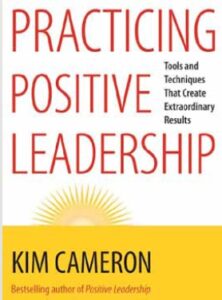Kim Cameron, professor and associate dean at the Center for Positive Organizational Scholarship from the University of Michigan, discusses his book Practicing Positive Leadership. It presents a set of proven and practical techniques to apply at work. This book may help skeptical managers to buy into positive leadership as it helps both people and organizations thrive. An interview and a book review.
Marcella Bremer: What’s an important added value of your book?
Kim Cameron: “Unless there is a scholarly foundation and research, things tend to be a fad. They come and go depending on what’s popular and hot. There are things that may be implemented but then again, fade quickly. One of the reasons is that there is no evidence that it really pays off. I feel that – at least from a University perspective – we need the foundation before the practice. It’s often the reverse – people try things without evidence on what really works. Our work at the Center for Positive Organizational Scholarship is to create the foundation and credibility and validity and then begin making practical applications.”
Marcella Bremer: You’ve been interested in organizational effectiveness for a long time and hence developed the Competing Values Framework. From where originates your interest in positive leadership?
Kim Cameron: “My interest in positive leadership began many years ago when I studied the phenomena of downsizing. What happens to organizations when they cut headcount and get smaller? One of the major outcomes of a decade of research was that almost all of the organizations that downsize, deteriorate in performance. Instead of getting better, they get worse. This happens for several reasons; conflict goes up, moral and innovation go down, loss of trust, etc. But 10-15% of organizations tend to flourish after downsizing! The question was: what was the difference between those who flourished and those who deteriorated?

The difference was what I refer to as organizational virtuousness. They implemented practices and processes that you can label virtuous: forgiveness, compassion, gratitude, integrity and so on. I didn’t have data at the time, but there was a major foundation sponsoring research on the topic of forgiveness so I applied for and obtained a grant.
That’s how I started on a big project on organizational forgiveness. From my research on downsizing, I knew that organizations that flourished in spite of everything were more optimistic looking at the future. They forgave the pain that was inflicted through the downsizing – instead of holding grudges and dwelling on the pain. That started the research on organizational virtuousness. The evidence over the last 10 years is clear: if you implement virtuousness in organizations, performance goes up, customer satisfaction goes up, everything gets better.
But how do you get an organization to implement or even take seriously the notion of virtuousness? That’s not even a scholarly word. It reminds you of programs in high schools or grandmother’s advice.
I wondered: what is it that leaders need to practice virtuousness? For me, leadership and virtuousness go hand in hand. My first book Positive Leadership was short because leaders don’t have time to read for long. But it contained the research that could convince positive leaders that virtuousness pays off. I meant to say: “Hey leaders, here are a few principles that once implemented, your organization will do better.”
Marcella Bremer: Is it possible for you, in your position as an associate dean, to practice the techniques of positive leadership in a university setting?
Kim Cameron: “I try to do that consistently. I would not say that I’m very good at it, but I try as best I can to put it into practice. What is interesting is that our Ross School of Business has identified four pillars for our work and those values drive our behaviors. One of those is “positive”. Making a positive difference in the world, having a positive organization, developing positive attributes.
In the business school, we have been very serious in putting those into our culture and it is part of the strategic direction. That makes it easier for the members to practice positive techniques: it has become legitimate and credible. Even though every staff member has to practice it themselves, the environment is supportive.”
Marcella Bremer: Is it harder to be kind at work nowadays because people are busy and just experienced the economic recession and may be scared?
Kim Cameron: “I think the environment creates more stress and pressure and there’s more impatience, criticism, and cynicism. Certainly at this moment the USA is rife with conflict, criticism, and negativity. On the other hand, we study organizations because we have seen that it is possible to create organizations that foster positive virtuousness
I’ll tell you the example of my colleague who became interested in positive organizations ten years ago. One of her daughters was abused by the babysitter, which is a very traumatic experience. She has a joint appointment at the University in the psychology department and the business school. Her psychology coworkers are wonderful people, but they reacted: “Yeah, bad things happen, better get over it.”
Her business school colleagues were very sensitive, empathetic and compassionate. The conclusion was: this is not only an individual attribute but organizations can create a kind culture and enable virtuousness to flourish. That was the start of research of positive virtues at an organizational level.
The job and duty of a leader is to help create an organization where it is easy to be supportive and to practice virtuousness, compassion and kindness. Where it is legitimate and natural to even love one another. When that happens, the data is very clear: organizational performance goes up.”
Marcella Bremer: If leaders read your new book, and they can take away only one thing, what would you like that to be?
Kim Cameron: “Good question. It might be the message: Take This Seriously. It’s often interpreted as touchy-feely and other negative labels: funny school material and airport bookstore advice. If you look on Amazon, there are 110.000 books on leadership! We don’t need one more, you could say. Why did I write this book? To show there is evidence that if you practice these principles, organizations are better off and so are the people that populate organizations. They flourish and you get outcomes you could not have achieved otherwise. So, take this seriously to improve and make a difference.”
Book Review: Practicing Positive Leadership, by Kim Cameron

Kim Cameron asked this question over a decade ago: what makes organizations perform spectacularly well? This led to his research on Positive Leadership: the objective is to create extraordinary performance, positively deviant results and remarkable vitality in the workplace. Organizations, as well as individuals, could benefit from this approach.
His first book, Positive Leadership, was inspiring because it was based on research and proved what many people intuitively know: it pays off to focus on the half-full glass and be as kind as possible. “Positive leadership is much too rare because people tend to focus on the negative. Organizations are usually in the business of solving problems,” states Cameron in the book. The added value for me was in the sound research presented, to convince skeptical managers who feared the “touchy-feely, happy hippie stuff”.
Positive Leadership contains four key strategies to create extraordinary performance in organizations: create a positive climate, positive relationships, communication and positive meaning. This new Practice book offers five specific positive practices to help leaders implement those four strategies. Though the book is founded on research, the tendency is more pragmatic. What can you do? What tools and techniques have proven positive outcomes?
This book explores how to create a culture of abundance, how to develop positive energy networks, how to deliver negative feedback positively, how to establish and achieve “everest goals” and how to apply positive leadership based on the Competing Values Framework.
The culture of abundance aims for the highest potential of the organization – instead of returning to normal after solving a problem. This Abundance approach creates positively deviant results because of the belief and faith that the organization can do better and its highest potential is possible.
Most organizations are likely to have to change their culture more or less to create “abundance”. The stages to change a culture toward abundance are to create readiness (by comparing yourself with better companies and modifying language and symbols), to overcome resistance (reduce what’s holding us back, increase what drives us), articulate a compelling vision of abundance (right- and left-brain approaches, a higher purpose, communicate what’s interesting), generate commitment (small wins and public commitments – so people will commit to their plans) and sustainability by metrics and relevant stories.
Positive energy networks means identifying the positive, open-minded people that everyone likes to work with and who seem energizing. Ask them as change champions or have them entice the others by giving them a visible, interactive position. They are reliable, transparent, and like to help others and be kind.
Cameron recommends to practice loving-kindness meditation and to keep a gratitude journal – proven to work well! Use game and fun elements at work, like we do in sports and play.
Positive communication is elaborated on by techniques as how-to-give-negative-feedback positively. This also covered by the excellent book Crucial Conversations (by Kerry Patterson) and there are many skills trainings as well. It covers how to communicate congruently, how to be descriptive instead of evaluative in your language, how to respond respectfully and share your own feelings. Proven fact: give three times more positive feedback than negative remarks!
Everest goals remind me of my NLP and skills training as well. You set goals that are SMART and go even further, using the Abundance mindset. Everest goals have an intrinsic value: they are good in themselves. They are positive, affirmative and strengthen faith. They contribute to a higher purpose and give thus meaning and energy. The set of questions Cameron provides is inspirational and easy to use during a team day away: What achievement would represent the very best our organization can be? What legacy would we like to leave behind? What do we care about deeply as an organization…? Serious questions that evoke answers to lift your team.

Last but not least, the book focuses on the 4 quadrants of the Competing Values Framework. Positive Leadership is NOT pampering people and touchy-feely stuff. In the people-oriented Clan quadrant, you empower people by enhancing their self-efficacy and self-determination and choice, personal consequences, meaning, and trust. In the results-oriented market quadrant, focus on surprising your customers and thus building customer loyalty. In the creative adhocracy quadrant, focus on developing reciprocity networks. People can publish their problems while others may offer or know resources to solve them – without expecting anything in return. That stimulates teamwork and new ideas…! In process-oriented hierarchy, eliminate inefficiencies from “procedure fat” to “career fat” to create positive performance again. All of this is explained with short examples and cases. You can apply the exercises immediately in your (client’s) organization.
For me, the great added value of this book is above all its scientific basis. We get a set of proven and practical techniques to apply immediately. The book may help skeptical managers to buy into kindness and positive leadership.
Marcella Bremer is an author and culture & change consultant. She co-founded this blog and ocai-online.com.
